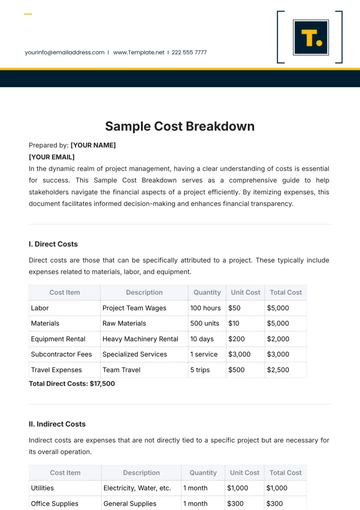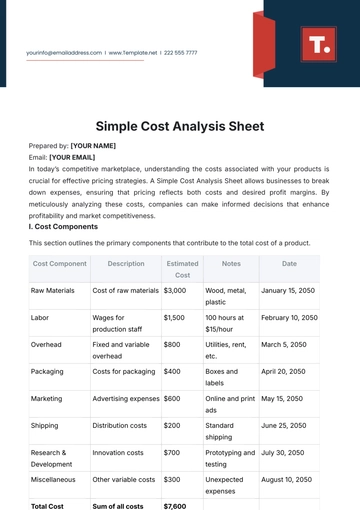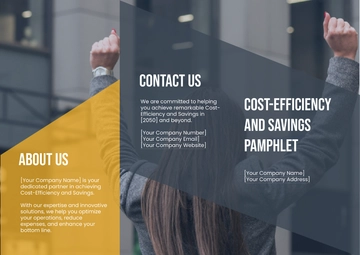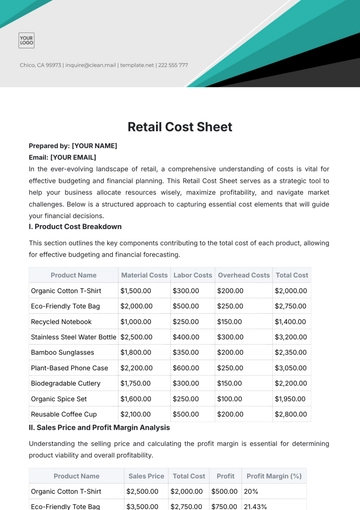Free Financial Cost Reduction Management

Executive Summary
A. [Your Company Name] Overview
[Your Company Name] is a distinguished leader in the health sector, pioneering innovation since our inception in [2050]. Renowned for our commitment to excellence, we have consistently delivered high-quality products and services to a diverse clientele.
The financial strength of [Your Company Name] is evident in the robust revenue of [$500 million] reported in the most recent fiscal year. As a company rooted in values and driven by innovation, [Your Company Name] aims to fortify its financial standing through strategic financial management.
B. Purpose of Financial Cost Reduction Management
In response to the evolving economic landscape and competitive challenges, [Your Company Name] is launching a strategic Financial Cost Reduction Management plan. The primary objective is to enhance operational efficiency, optimize expenditures, and solidify our financial foundation.
This initiative targets a [15%] reduction in overall costs, aiming for increased profitability and long-term financial resilience. By aligning our cost structure with industry best practices, [Your Company Name] seeks to elevate its competitiveness and sustain growth in the dynamic market.
Current Financial Landscape
A. Financial Assessment
A comprehensive evaluation of [Your Company Name]'s financial performance in the fiscal year ending [December 31, 2051] reveals a robust revenue stream of [$500 million]. Operating expenses, covering production costs, marketing outlays, and administrative expenditures, totaled [$350 million], resulting in a net profit of [$150 million].
Key Financial Metrics:
Revenue: | [$500 million] |
Operating Expenses: | [$350 million] |
Net Profit: | [$150 million] |
Profit Margin: | [30%] |
B. Cost Breakdown
Breaking down the cost structure, key expenses are attributed to critical areas such as production, marketing, and administrative overheads. These components form the crux of our cost structure, with specific figures as follows:
Cost Components:
Production Costs: | [$120 million] |
Marketing Expenses: | [$80 million] |
Administrative Overheads: | [$150 million] |
Cost Reduction Strategy
A. Cost Reduction Goals
To achieve our targeted [15%] reduction in overall costs, [Your Company Name] has established specific goals for each cost category:
Production Costs: Targeting a [10%] reduction through operational efficiency improvements, strategic sourcing, and waste reduction initiatives.
Marketing Expenses: Aiming for a [15%] reduction by optimizing advertising campaigns, negotiating favorable vendor agreements, and leveraging digital marketing channels.
Administrative Overheads: Targeting a [20%] reduction through process automation, streamlining workflows, and renegotiating contracts with service providers.
B. Cost Reduction Initiatives
Operational Efficiency Improvements
To enhance operational efficiency and achieve cost savings in production, [Your Company Name] will implement the following initiatives:
Process Optimization: Conduct a comprehensive review of production processes to identify inefficiencies and implement streamlined workflows.
Technology Integration: Invest in state-of-the-art technology to automate routine tasks, reducing labor costs and minimizing production time.
Employee Training: Provide training programs to empower employees with the skills necessary to operate efficiently, minimizing errors and delays.
Projected Cost Savings: [$30 million]
Timeline: Implementation to be completed within [12 months]
Vendor Management
Efficient management of vendor relationships is crucial for cost reduction. [Your Company Name] will undertake the following steps:
Negotiation Strategies: Train procurement teams in effective negotiation strategies to secure better terms, discounts, and favorable payment terms.
Supplier Consolidation: Consolidate suppliers where feasible to benefit from bulk discounts and improved negotiation leverage.
Regular Vendor Audits: Conduct regular audits to ensure vendors adhere to agreed-upon terms and identify opportunities for further cost optimization.
Projected Cost Savings: [$20 million]
Timeline: Continuous improvement, with initial impact expected within [6 months]
Technology Optimization
Utilizing technology for efficiency gains and cost reduction is a key focus area for [Your Company Name]:
Automation Solutions: Implement automation tools to reduce manual intervention in administrative processes, minimizing errors and saving time.
Data Analytics: Utilize data analytics to identify areas for improvement, cost-saving opportunities, and predictive maintenance in operations.
IT Infrastructure Upgrade: Invest in upgrading IT infrastructure to support advanced technology solutions and improve overall system reliability.
Projected Cost Savings: [$25 million]
Timeline: Implementation over [18 months], with initial benefits realized within the first [6 months]
Implementation Plan
A. Timeline
The implementation of cost reduction initiatives will be phased over the next [24 months]:
Operational Efficiency Improvements: | Months 1-12 |
Vendor Management: | Continuous improvement, with significant impact expected within the first 6 months. |
Technology Optimization: | Months 6-24 |
B. Resource Allocation
Resources required for successful implementation include:
Financial Resources: Allocated budget of [$50 million] for technology upgrades, training programs, and initial investments in operational improvements.
Human Resources: Dedicated teams for each initiative, comprising experts in process optimization, procurement, technology, and project management.
Monitoring and Evaluation
A. Key Performance Indicators (KPIs)
To assess the effectiveness of the cost reduction initiatives, [Your Company Name] will monitor key performance indicators (KPIs) aligned with the goals:
Cost-to-Revenue Ratio: Tracking the percentage of costs relative to revenue, aiming for a reduction to [18%] over the next 24 months.
Operating Margin: Monitoring improvements in operating margin, with a target increase of [5%] to reflect enhanced profitability.
Return on Investment (ROI): Evaluating the ROI of technology investments, aiming for a minimum [15%] increase in efficiency.
Employee Productivity: Assessing the impact of operational efficiency improvements on employee productivity, with a target increase of [10%].
B. Reporting Mechanism
Regular updates on the progress of the cost reduction plan will be communicated through the following channels:
Monthly Reports: Detailed reports will be generated and circulated internally to all relevant stakeholders, providing a comprehensive overview of key performance metrics.
Quarterly Presentations: Quarterly presentations will be conducted to share progress with executive leadership, addressing any challenges and adjustments to the plan.
Real-time Dashboards: Implementing real-time dashboards accessible to key decision-makers, providing instant insights into ongoing initiatives and their impact.
Risk Management
A. Identification
Identifying potential risks and challenges associated with the cost reduction initiatives is critical for proactive management. Key risks include:
Resistance to Change: Anticipating employee resistance to new technologies or process changes and implementing change management strategies.
Market Fluctuations: Considering external factors such as economic downturns or shifts in market demand that may impact the effectiveness of cost reduction strategies.
Technology Implementation Risks: Addressing potential challenges in implementing new technologies, such as system integration issues or employee training hurdles.
B. Mitigation Strategies
To mitigate the identified risks, [Your Company Name] will implement the following strategies:
Employee Engagement Programs: Launching employee engagement programs to communicate the benefits of the changes and involve staff in the decision-making process.
Scenario Planning: Conducting regular scenario planning sessions to anticipate and prepare for potential market fluctuations.
Pilot Programs: Implementing pilot programs for new technologies on a smaller scale before full deployment to identify and address any implementation challenges.
Communication Plan
A. Internal Communication
For successful implementation of the cost reduction plan, effective internal communication is paramount. [Your Company Name] will employ the following strategies:
Employee Town Hall Meetings: Conducting regular town hall meetings to communicate the purpose, benefits, and progress of the cost reduction plan. These sessions will provide employees with a platform to ask questions and express concerns.
Intranet Updates: Regular updates on the company's intranet platform, outlining key milestones, success stories, and upcoming initiatives. This ensures that all employees are informed and engaged in the process.
Training Workshops: Organizing training workshops to equip employees with the skills necessary to adapt to new technologies and processes. This proactive approach minimizes resistance and enhances overall understanding.
B. External Communication
While maintaining transparency with internal stakeholders, [Your Company Name] will also communicate effectively with external parties:
Client Updates: Providing regular updates to clients on any changes that may impact the delivery of products or services. Clear communication will build trust and manage expectations.
Investor Relations: Issuing timely reports to investors, outlining the positive impact of the cost reduction plan on financial performance. This ensures investors are well-informed about the company's strategic initiatives.
Public Relations: Managing public relations to convey a positive image of [Your Company Name] during the implementation phase. This involves communicating the company's commitment to sustainability, efficiency, and long-term growth.
Stakeholder Engagement
A. Stakeholder Analysis
A crucial aspect of successful cost reduction management is engaging with and managing the expectations of various stakeholders. [Your Company Name] will conduct a thorough stakeholder analysis to identify and categorize key stakeholders, including:
Internal Stakeholders: Employees, managers, and executives directly involved in the implementation of cost reduction initiatives. Regular engagement will ensure alignment with company goals and mitigate potential resistance.
External Stakeholders: Clients, suppliers, investors, and regulatory bodies. Clear communication will be maintained to manage expectations, address concerns, and foster positive relationships.
B. Stakeholder Communication
Tailored communication strategies will be developed for each stakeholder group:
Regular Updates: Internal stakeholders will receive frequent updates through newsletters, team meetings, and direct communication channels.
Client Collaboration: Engaging with clients through collaborative forums, seeking feedback on service adjustments, and ensuring minimal disruption during the implementation phase.
Investor Briefings: Conducting periodic briefings with investors to provide insights into the positive impact of cost reduction on financial performance and long-term sustainability.
Supplier Collaboration: Collaborating closely with suppliers, offering transparent communication on changes in procurement processes, and ensuring continuity in partnerships.
Conclusion
[Your Company Name] is dedicated to navigating the dynamic market landscape through a robust Financial Cost Reduction Management plan. This strategic initiative aims to enhance operational efficiency, optimize expenditures, and fortify our financial foundation.
The comprehensive plan outlined in this document, with specific goals, targeted initiatives, and a structured implementation timeline, positions [Your Company Name] for sustained success. As we embark on this journey, we remain committed to transparency, innovation, and delivering value to our stakeholders.
- 100% Customizable, free editor
- Access 1 Million+ Templates, photo’s & graphics
- Download or share as a template
- Click and replace photos, graphics, text, backgrounds
- Resize, crop, AI write & more
- Access advanced editor
Optimize financial efficiency with the Financial Cost Reduction Management Template on Template.net. This editable and customizable template streamlines cost reduction strategies. Tailor content effortlessly using our Ai Editor Tool, ensuring adaptability and precision. Elevate your financial management with this user-friendly template, offering a comprehensive approach to crafting personalized cost reduction plans for informed decision-making and strategic financial planning.





























